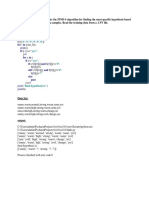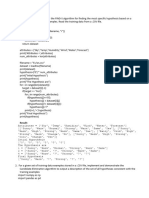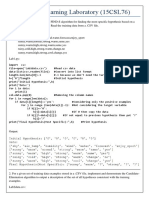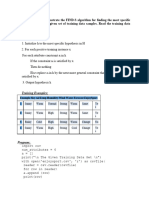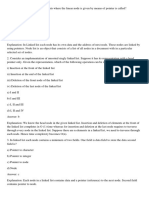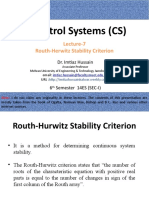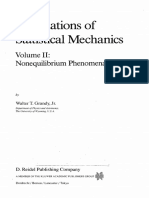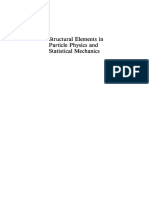Ad3461 ML Lab Manual Format Edited
Uploaded by
mohanapriya mohanapriyaAd3461 ML Lab Manual Format Edited
Uploaded by
mohanapriya mohanapriyalOMoARcPSD|47101843
AD3461 ML Lab Manual format edited
Machine Learning Lab (SRM Institute of Science and Technology)
Scan to open on Studocu
Studocu is not sponsored or endorsed by any college or university
Downloaded by Sharmi Rks (sharmirks74@gmail.com)
lOMoARcPSD|47101843
Ex No: 1 IMPLEMENTATION OF CANDIDATE ELIMINATION ALGORITHM
AIM:
To implement Candidate Elimination Algorithm using python script.
ALGORITHM:
Step 1: Initialize the version space.
● Initialize the most general hypothesis (h_G) to the maximally general hypothesis
(all attributes set to '?').
● Initialize the most specific hypothesis (h_S) to the maximally specific hypothesis
(all attributes set to specific values or 'null' if not possible).
Step 2: Iterate through the training examples.
● For each positive example, update h_G and h_S as follows:
● For each attribute that does not match the positive example, make it
more specific in h_G.
● For each attribute that matches the positive example, make it more
specific in h_S.
● For each negative example, update h_G and h_S as follows:
● For each attribute that does not match the negative example, make it
more specific in h_S.
● For each attribute that matches the negative example, make it more
specific in h_G.
Step 3: Refine the version space.
Downloaded by Sharmi Rks (sharmirks74@gmail.com)
lOMoARcPSD|47101843
● Remove any hypothesis from the version space that is more general than
another hypothesis or more specific than another hypothesis.
Step 4: Repeat Steps 2 and 3 until convergence.
● Keep iterating through the training examples and refining the version space
until it becomes consistent, i.e., contains only one specific hypothesis that
correctly classifies all the training examples.
Step 5: Output the final hypothesis.
PROGRAM:
import numpy as np
import pandas as pd
data = pd.DataFrame(data=pd.read_csv('finds1.csv'))
concepts = np.array(data.iloc[:,0:-1])
target = np.array(data.iloc[:,-1])
def learn(concepts, target):
specific_h = concepts[0].copy()
print("initialization of specific_h and general_h")
Downloaded by Sharmi Rks (sharmirks74@gmail.com)
lOMoARcPSD|47101843
print(specific_h)
general_h = [["?" for i in range(len(specific_h))] for i in range(len(specific_h))]
print(general_h)
for i, h in enumerate(concepts):
if target[i] == "Yes":
for x in range(len(specific_h)):
if h[x] != specific_h[x]:
specific_h[x] = '?'
general_h[x][x] = '?'
if target[i] == "No":
for x in range(len(specific_h)):
if h[x] != specific_h[x]:
general_h[x][x] = specific_h[x]
else:
general_h[x][x] = '?'
print(" steps of Candidate Elimination Algorithm",i+1)
print("Specific_h ",i+1,"\n ")
print(specific_h)
print("general_h ", i+1, "\n ")
print(general_h)
indices = [i for i, val in enumerate(general_h) if val == ['?', '?', '?', '?', '?', '?']]
Downloaded by Sharmi Rks (sharmirks74@gmail.com)
lOMoARcPSD|47101843
for i in indices:
general_h.remove(['?', '?', '?', '?', '?', '?'])
return specific_h, general_hs_final, g_final = learn(concepts, target)
print("Final Specific_h:", s_final, sep="\n")
print("Final General_h:", g_final, sep="\n")
Downloaded by Sharmi Rks (sharmirks74@gmail.com)
lOMoARcPSD|47101843
OUTPUT:
initialization of specific_h and general_h
['Cloudy' 'Cold' 'High' 'Strong' 'Warm' 'Change']
[['?', '?', '?', '?', '?', '?'], ['?', '?', '?', '?', '?', '?'], ['?', '?', '?', '?', '?', '?'], ['?', '?', '?', '?', '?', '?'], ['?', '?', '?',
'?', '?', '?'], ['?', '?', '?', '?', '?', '?']]
steps of Candidate Elimination Algorithm 8
Specific_h 8
['?' '?' '?' 'Strong' '?' '?']
general_h 8
[['?', '?', '?', '?', '?', '?'], ['?', '?', '?', '?', '?', '?'], ['?', '?', '?', '?', '?', '?'], ['?', '?', '?', 'Strong', '?', '?'], ['?',
'?', '?', '?', '?', '?'], ['?', '?', '?', '?', '?', '?']]
Final Specific_h:
['?' '?' '?' 'Strong' '?' '?']
Final General_h:
[['?', '?', '?', 'Strong', '?', '?']]
Downloaded by Sharmi Rks (sharmirks74@gmail.com)
lOMoARcPSD|47101843
RESULT:
Thus the implementation candidate - Elimination algorithm has been implemented
successfully
Ex.No: 2 IMPLEMENTATION OF DECISION TREE BASED ID3 ALGORITHM
AIM:
To implement Decision Tree Based ID3 Algorithm using python script.
ALGORITHM:
Step 1: Start the program
Step 2: Load the dataset and organize it into a table, with rows representing instances and
columns representing features. The last column should contain the class labels.
Step 3: Define a function to calculate the entropy of the dataset. Entropy measures the
uncertainty in the dataset based on class distribution.
Downloaded by Sharmi Rks (sharmirks74@gmail.com)
lOMoARcPSD|47101843
Step 4: For each feature, calculate the information gain. Information gain measures how
much a feature contributes to reducing the uncertainty in the dataset.
Step 5: Select the feature with the highest information gain as the best feature to split the
dataset.
Step 6: Divide the dataset into subsets based on the values of the best feature found in
Step 4.
Step 7: Repeat Recursively
Step 8: Build the decision tree by assigning the best feature as the splitting criterion at
each internal node and the majority class as the class label for each leaf node.
Step 9: Use the created decision tree to classify new instances by traversing the tree from
the root to the appropriate leaf node based on their feature values.
Step 10: Evaluate the Model
Step 11: Stop the program
PROGRAM:
import pandas as pd
import numpy as np
dataset=pd.read_csv('playtennis.csv',names=['outlook','temperature','humidity','wind','class',])
def entropy(target_col):
elements,counts = np.unique(target_col,return_counts = True)
entropy=np.sum([(counts[i]/np.sum(counts))*np.log2(counts[i]/np.sum(counts)) for i in
range(len(elements))])
return entropy
def InfoGain(data,split_attribute_name,target_name="class"):
Downloaded by Sharmi Rks (sharmirks74@gmail.com)
lOMoARcPSD|47101843
total_entropy = entropy(data[target_name])
vals,counts= np.unique(data[split_attribute_name],return_counts=True)
Weighted_Entropy=np.sum([counts[i]/np.sum(counts))*entropy(data.where(data[split_attrib
ute_name]==vals[i].dropna()[target_name]) for i in range(len(vals))])
Information_Gain = total_entropy - Weighted_Entropy
return Information_Gain
def ID3(data,originaldata,features,target_attribute_name="class",
parent_node_class = None):
if len(np.unique(data[target_attribute_name])) <= 1:
return np.unique(data[target_attribute_name])[0]
elif len(data)==0:
returnnp.unique(originaldata[target_attribute_name])
[np.argmax(np.uniqe(originaldata[target_attribute_name],return_counts=True)[1])]
elif len(features) ==0:
return parent_node_class
else:
parent_node_classnp.unique(data[target_attribute_name])
[np.argmax(np.unique(data[target_attribute_name],return_counts=True)[1])]
item_values = [InfoGain(data,feature,target_attribute_name) for feature in features]
#Return the information gain values for the features in the dataset
best_feature_index = np.argmax(item_values)
best_feature = features[best_feature_index]
Downloaded by Sharmi Rks (sharmirks74@gmail.com)
lOMoARcPSD|47101843
tree = {best_feature:{}}
features = [i for i in features if i != best_feature]
for value in np.unique(data[best_feature]):
value = value
sub_data = data.where(data[best_feature] == value).dropna()
subtree=ID3(sub_data,dataset,features,target_attribute_name,parent_node_class)
tree[best_feature][value] = subtree
return(tree)
tree = ID3(dataset,dataset,dataset.columns[:-1])
print(' \nDisplay Tree\n',tree)
OUTPUT:
Display Tree
{'outlook': {'Overcast': 'Yes', 'Rain': {'wind': {'Strong': 'No', 'Weak': 'Yes'}}, 'Sunny':
{'humidity': {'High': 'No', 'Normal': 'Yes'}}}}
Downloaded by Sharmi Rks (sharmirks74@gmail.com)
lOMoARcPSD|47101843
10
RESULT:
Thus the implementation candidate - Elimination algorithm has been implemented successfully
EX NO.3 IMPLEMENTATION OF ARTIFICIAL NEURAL NETWORK USING BACK
PROPAGATION ALGORITHM
AIM:
To implement Artificial Neural Network using back Propagation Algorithm using python
script.
ALGORITHM:
Step 1: Inputs X, arrive through the preconnected path.
Step 2: The input is modeled using true weights W. Weights are usually chosen randomly.
Step 3: Calculate the output of each neuron from the input layer to the hidden layer to the
output layer.
Downloaded by Sharmi Rks (sharmirks74@gmail.com)
lOMoARcPSD|47101843
11
Step 4: Calculate the error in the outputs
Step 5: From the output layer, go back to the hidden layer to adjust the weights to reduce
the error.
Step 6: Repeat the process until the desired output is achieved.
PROGRAM:
import numpy as np
X = np.array(([2, 9], [1, 5], [3, 6]), dtype=float)
y = np.array(([92], [86], [89]), dtype=float)
X = X/np.amax(X,axis=0) # maximum of X array longitudinally y = y/100
#Sigmoid Function
def sigmoid (x):
return (1/(1 + np.exp(-x)))
#Derivative of Sigmoid Function
def derivatives_sigmoid(x):
return x * (1 - x)
#Variable initialization
epoch=7000 #Setting training iterations
lr=0.1 #Setting learning rate
inputlayer_neurons = 2 #number of features in data set
hiddenlayer_neurons = 3 #number of hidden layers neurons
output_neurons = 1 #number of neurons at output layer
Downloaded by Sharmi Rks (sharmirks74@gmail.com)
lOMoARcPSD|47101843
12
#weight and bias initialization
wh=np.random.uniform(size=(inputlayer_neurons,hiddenlayer_neurons))
bh=np.random.uniform(size=(1,hiddenlayer_neurons))
wout=np.random.uniform(size=(hiddenlayer_neurons,output_neurons))
bout=np.random.uniform(size=(1,output_neurons))
# draws a random range of numbers uniformly of dim x*y
#Forward Propagation
for i in range(epoch):
hinp1=np.dot(X,wh)
hinp=hinp1 + bh
hlayer_act = sigmoid(hinp)
outinp1=np.dot(hlayer_act,wout)
outinp= outinp1+ bout
output = sigmoid(outinp)
#Backpropagation
EO = y-output
outgrad = derivatives_sigmoid(output)
d_output = EO* outgrad
EH = d_output.dot(wout.T)
hiddengrad = derivatives_sigmoid(hlayer_act)
Downloaded by Sharmi Rks (sharmirks74@gmail.com)
lOMoARcPSD|47101843
13
#how much hidden layer wts contributed to error
d_hiddenlayer = EH * hiddengrad
wout += hlayer_act.T.dot(d_output) *lr
# dotproduct of nextlayererror and currentlayerop
bout += np.sum(d_output, axis=0,keepdims=True) *lr
wh += X.T.dot(d_hiddenlayer) *lr
#bh += np.sum(d_hiddenlayer, axis=0,keepdims=True) *lr
print("Input: \n" + str(X))
print("Actual Output: \n" + str(y))
print("Predicted Output: \n" ,output)
OUTPUT:
Input:
[[ 0.66666667 1. ]
[ 0.33333333 0.55555556]
[ 1. 0.66666667]]
Actual Output:
[[ 0.92]
[ 0.86]
[ 0.89]]
Predicted Output:
Downloaded by Sharmi Rks (sharmirks74@gmail.com)
lOMoARcPSD|47101843
14
[[ 0.89559591]
[ 0.88142069]
[ 0.8928407 ]]
RESULT:
Thus the implementation of back propagation algorithm has been done successfully.
EX.NO 4: IMPLEMENTATION OF NAIVE BAYESIAN CLASSIFIER
AIM:
To implement Naïve Bayesian Classifier using python script.
ALGORITHM:
Step 1: Data Pre-processing step
Step 2: Fitting Naive Bayes to the Training set
Step 3: Predicting the test result
Step 4: Test accuracy of the result(Creation of Confusion matrix)
Downloaded by Sharmi Rks (sharmirks74@gmail.com)
lOMoARcPSD|47101843
15
Step 5: Visualizing the test set result.
PROGRAM:
import pandas as pd
msg=pd.read_csv('naivetext1.csv',names=['message','label'])
print('The dimensions of the dataset',msg.shape)
msg['labelnum']=msg.label.map({'pos':1,'neg':0})
X=msg.message
y=msg.labelnum
print(X)
print(y)
from sklearn.model_selection import train_test_split
xtrain,xtest,ytrain,ytest=train_test_split(X,y)
print(xtest.shape)
print(xtrain.shape)
print(ytest.shape)
print(ytrain.shape)
from sklearn.feature_extraction.text import CountVectorizer
count_vect = CountVectorizer()
xtrain_dtm = count_vect.fit_transform(xtrain)
xtest_dtm=count_vect.transform(xtest)
Downloaded by Sharmi Rks (sharmirks74@gmail.com)
lOMoARcPSD|47101843
16
from sklearn.naive_bayes import MultinomialNB
clf = MultinomialNB().fit(xtrain_dtm,ytrain)
predicted = clf.predict(xtest_dtm)
from sklearn import metrics
print('Accuracy metrics')
print('Accuracy of the classifer is',metrics.accuracy_score(ytest,predicted))
print('Confusion matrix')
print(metrics.confusion_matrix(ytest,predicted))
print('Recall and Precison ')
print(metrics.recall_score(ytest,predicted))
print(metrics.precision_score(ytest,predicted))
OUTPUT:
The dimensions of the dataset (18, 2)
0 I love this sandwich
1 This is an amazing place
2 I feel very good about these beers
3 This is my best work
4 What an awesome view
5 I do not like this restaurant
6 I am tired of this stuff
7 I can't deal with this
Downloaded by Sharmi Rks (sharmirks74@gmail.com)
lOMoARcPSD|47101843
17
8 He is my sworn enemy
9 My boss is horrible
10 This is an awesome place
11 I do not like the taste of this juice
12 I love to dance
13 I am sick and tired of this place
14 What a great holiday
15 That is a bad locality to stay
16 We will have good fun tomorrow
17 I went to my enemy's house today
Name: message, dtype: object
01
11
21
31
41
50
60
70
80
90
10 1
Downloaded by Sharmi Rks (sharmirks74@gmail.com)
lOMoARcPSD|47101843
18
11 0
12 1
13 0
14 1
15 0
16 1
17 0
Name: labelnum, dtype: int64
(5,)
(13,)
(5,)
(13,)
Accuracy metrics
Accuracy of the classifer is 0.8
Confusion matrix
[[3 1]
[0 1]]
Recall and Precison
1.0
0.5
Downloaded by Sharmi Rks (sharmirks74@gmail.com)
lOMoARcPSD|47101843
19
RESULT:
Thus the implementation of Naive Bayesian Classifier algorithm has been done
successfully.
EX NO 5: IMPLEMENTATION OF NAIVE BAYESIAN CLASSIFIER MODEL TO
CLASSIFY A SET OF DOCUMENTS
Downloaded by Sharmi Rks (sharmirks74@gmail.com)
lOMoARcPSD|47101843
20
AIM:
To implement the Naïve Bayesian Classifier Model to Classify the document set using
python.
ALGORITHM:
Step 1: Input the total Number of Documents from the user.
Step 2: Input the text and class of Each document and split it into a List.
Step 3: Create a 2D array and append each document list into an array
Step 4: Using a Set data structure, store all the keywords in a list.
Step 5: Input the text to be classified by the user.
PROGRAM:
import csv
import random
import math
def loadCsv(filename):
lines = csv.reader(open(filename, "r"));
dataset = list(lines)
for i in range(len(dataset)):
#converting strings into numbers for processing
dataset[i] = [float(x) for x in dataset[i]]
return dataset
def splitDataset(dataset, splitRatio):
#67% training size
trainSize = int(len(dataset)* splitRatio);
trainSet = []
copy = list(dataset);
while len(trainSet) < trainSize:
#generate indices for the dataset list randomly to pick ele for training data
Downloaded by Sharmi Rks (sharmirks74@gmail.com)
lOMoARcPSD|47101843
21
index = random.randrange(len(copy));
trainSet.append(copy.pop(index))
return [trainSet, copy]
def separateByClass(dataset):
separated = {}
#creates a dictionary of classes 1 and 0 where the values are the instacnes
belonging to each class
for i in range(len(dataset)):
vector = dataset[i]
if (vector[-1] not in separated):
separated[vector[-1]] = []
separated[vector[-1]].append(vector)
return separated
def mean(numbers):
return sum(numbers)/float(len(numbers))
def stdev(numbers):
avg = mean(numbers)
variance = sum([pow(x-avg,2) for x in numbers])/float(len(numbers)-1)
return math.sqrt(variance)
def summarize(dataset):
summaries = [(mean(attribute), stdev(attribute)) for attribute in zip(*dataset)];
del summaries[-1]
return summaries
def summarizeByClass(dataset):
separated = separateByClass(dataset);
summaries = {}
for classValue, instances in separated.items():
#summaries is a dic of tuples(mean,std) for each class value
summaries[classValue] = summarize(instances)
return summaries
def calculateProbability(x, mean, stdev):
exponent = math.exp(-(math.pow(x-mean,2)/(2*math.pow(stdev,2))))
return (1 / (math.sqrt(2*math.pi) * stdev)) * exponent
Downloaded by Sharmi Rks (sharmirks74@gmail.com)
lOMoARcPSD|47101843
22
def calculateClassProbabilities(summaries, inputVector):
probabilities = {}
for classValue, classSummaries in summaries.items():#class and attribute information
as mean and sd
probabilities[classValue] = 1
for i in range(len(classSummaries)):
mean, stdev = classSummaries[i] #take mean and sd of every attribute
for class 0 and 1 seperaely
x = inputVector[i] #testvector's first attribute
probabilities[classValue] *= calculateProbability(x, mean, stdev);#use
normal dist
return probabilities
def predict(summaries, inputVector):
probabilities = calculateClassProbabilities(summaries, inputVector)
bestLabel, bestProb = None, -1
for classValue, probability in probabilities.items():#assigns that class which has he
highest prob
if bestLabel is None or probability > bestProb:
bestProb = probability
bestLabel = classValue
return bestLabel
def getPredictions(summaries, testSet):
predictions = []
for i in range(len(testSet)):
result = predict(summaries, testSet[i])
predictions.append(result)
return predictions
def getAccuracy(testSet, predictions):
correct = 0
for i in range(len(testSet)):
if testSet[i][-1] == predictions[i]:
correct += 1
return (correct/float(len(testSet))) * 100.0
Downloaded by Sharmi Rks (sharmirks74@gmail.com)
lOMoARcPSD|47101843
23
def main():
filename = '5data.csv' splitRatio = 0.67
dataset = loadCsv(filename);
trainingSet, testSet = splitDataset(dataset, splitRatio)
print('Split {0} rows into train={1} and test={2} rows'.format(len(dataset),
len(trainingSet), len(testSet)))
# prepare model
summaries = summarizeByClass(trainingSet);
# test model
predictions = getPredictions(summaries, testSet)
accuracy = getAccuracy(testSet, predictions)
print('Accuracy of the classifier is : {0}%'.format(accuracy))
main()
OUTPUT:
confusion matrix is as
follows [[17 0 0]
[ 0 17 0]
[ 0 0 11]]
Accuracy metrics
precision recall f1-score support
0 1.00 1.00 1.00 17
1 1.00 1.00 1.00 17
2 1.00 1.00 1.00 11
avg / total 1.00 1.00 1.00 45
RESULT:
Thus the implementation of Naïve Bayesian Classifier model has been done successfully.
Downloaded by Sharmi Rks (sharmirks74@gmail.com)
lOMoARcPSD|47101843
24
EX NO 6: CONSTRUCTING A BAYESIAN NETWORK TO DIAGNOSE AN
INFECTION USING WHO DATA SET.
AIM:
To implement a Bayesian Network to diagnose an infection with WHO dataset using
python script.
ALGORITHM:
Step 1:
Step 2:
Step 3:
Step 4:
Step 5:
Step 6:
Step 7:
Step 8:
Step 9:
PROGRAM:
Downloaded by Sharmi Rks (sharmirks74@gmail.com)
lOMoARcPSD|47101843
25
Downloaded by Sharmi Rks (sharmirks74@gmail.com)
lOMoARcPSD|47101843
26
OUTPUT:
Downloaded by Sharmi Rks (sharmirks74@gmail.com)
lOMoARcPSD|47101843
27
RESULT:
To the implementation of a Bayesian Network to diagnose an infection with WHO dataset
has been done successfully
Downloaded by Sharmi Rks (sharmirks74@gmail.com)
lOMoARcPSD|47101843
28
EX NO: 7 IMPLEMENTATION OF EM ALGORITHM TO CLUSTER A SET OF
DATA
AIM:
To implement EM algorithm to cluster a data set using python.
ALGORITHM:
Step 1: Identify the variable in which the set of attributes are specified in the data set
Step 2: Determine the domain of each variable to take from the set of values.
Step 3: Create a directed graph network or node where each node represents the attributes
and edges represents child relationship.
Step 4: Determine the prior and conditional probability for each attribute
Step 5: Perform the inference on the module and determine the marginal probability.
PROGRAM:
import numpy as np
from sklearn.cluster import KMeans
import matplotlib.pyplot as plt
from sklearn.mixture import GaussianMixture
import pandas as pd
X=pd.read_csv("kmeansdata.csv")
x1 = X['Distance_Feature'].values
x2 = X['Speeding_Feature'].values
X = np.array(list(zip(x1, x2))).reshape(len(x1), 2)
plt.plot()
Downloaded by Sharmi Rks (sharmirks74@gmail.com)
lOMoARcPSD|47101843
29
plt.xlim([0, 100])
plt.ylim([0, 50])
plt.title('Dataset')
plt.scatter(x1, x2)
plt.show()
#code for EM
gmm = GaussianMixture(n_components=3)
gmm.fit(X)
em_predictions = gmm.predict(X)
print("\nEM predictions")
print(em_predictions)
print("mean:\n",gmm.means_)
print('\n')
print("Covariances\n",gmm.covariances_)
print(X)
plt.title('Exceptation Maximum')
plt.scatter(X[:,0], X[:,1],c=em_predictions,s=50)
plt.show()
#code for Kmeans
import matplotlib.pyplot as plt1
kmeans = KMeans(n_clusters=3)
Downloaded by Sharmi Rks (sharmirks74@gmail.com)
lOMoARcPSD|47101843
30
kmeans.fit(X)
print(kmeans.cluster_centers_)
print(kmeans.labels_)
plt.title('KMEANS')
plt1.scatter(X[:,0], X[:,1], c=kmeans.labels_, cmap='rainbow')
plt1.scatter(kmeans.cluster_centers_[:,0] ,kmeans.cluster_centers_[:,1], color='black')
OUTPUT:
EM predictions
[0 0 0 1 0 1 1 1 2 1 2 2 1 1 2 1 2 1 0 1 0 1 1]
mean: [[57.70629058 25.73574491][52.12044022 22.46250453]
[46.4364858 39.43288647]]
Covariances [[[83.51878796 14.926902 ] [14.926902 2.70846907]] [[29.95910352 15.83416554]
[15.83416554 67.01175729]]
[[79.34811849 29.55835938] [29.55835938 18.17157304]]] [[71.24 28. ] [52.53 25. ] [64.54 27. ]
[55.69 22. ] [54.58 25. ] [41.91 10. ] [58.64 20. ] [52.02 8. ] [31.25 34. ] [44.31 19. ] [49.35 40. ]
[58.07 45. ] [44.22 22. ] [55.73 19. ] [46.63 43. ] [52.97 32. ] [46.25 35. ] [51.55 27. ] [57.05 26. ]
[58.45 30. ] [43.42 23. ] [55.68 37. ] [55.15 18. ][[57.74090909 24.27272727] [48.6 38. ] [45.176
16.4 ]]
[0 0 0 0 0 2 0 2 1 2 1 1 2 0 1 1 1 0 0 0 2 1 0]
Downloaded by Sharmi Rks (sharmirks74@gmail.com)
lOMoARcPSD|47101843
31
RESULT:
Thus the EM Algorithm to cluster a data set has been implemented successfully.
Downloaded by Sharmi Rks (sharmirks74@gmail.com)
lOMoARcPSD|47101843
32
EX NO 8: IMPLEMENTATION OF K-NEAREST NEIGHBOUR
ALGORITHM TO CLASSIFY IRIS DATASET
AIM:
To implement the K-Nearest Neighbour Algorithm to classify the Dataset using python
ALGORITHM:
Step 1: Start the Program
Step 2: Importing the Modules.
Step 3: Creating dataset, scikit_learn has a lot of tools for creating synthetic datasets.
Step 4: Visualize the dataset
Step 5: Splitting data into training and testing dataset.
Step 6: Build a KNN classifier object for the implementation.
Step 7: Predictions for the KNN Classifier, then in the test set, we forecast the target
values and compare them to the actual values.
Step 8: Predict Accuracy for both K-values
Step 9: Visualize Predictions
Step 10: Stop the Program.
PROGRAM:
import numpy as np
import pandas as pd
from sklearn.neighbors import KNeighborsClassifier
from sklearn.model_selection import train_test_split
Downloaded by Sharmi Rks (sharmirks74@gmail.com)
lOMoARcPSD|47101843
33
from sklearn import metrics
from sklearn.datasets import load_iris
iris=load_iris()
iris.keys()
df=pd.DataFrame(iris['data'])
X=df
y=iris['target']
print(X.head())
Xtrain, Xtest, ytrain, ytest = train_test_split(X, y, test_size=0.10)
classifier = KNeighborsClassifier(n_neighbors=3).fit(Xtrain, ytrain)
ypred = classifier.predict(Xtest)
i=0
print ("\n-------------------------------------------------------------------------")
print ('%-25s %-25s %-25s' % ('Original Label', 'Predicted Label', 'Correct/Wrong'))
print ("-------------------------------------------------------------------------")
for label in ytest:
print ('%-25s %-25s' % (label, ypred[i]), end="")
if (label == ypred[i]):
print (' %-25s' % ('Correct'))
else:
print (' %-25s' % ('Wrong'))
i=i+1
print ("-------------------------------------------------------------------------")
print("\nConfusion Matrix:\n",metrics.confusion_matrix(ytest, ypred))
print ("-------------------------------------------------------------------------")
print("\nClassification Report:\n",metrics.classification_report(ytest, ypred))
print ("-------------------------------------------------------------------------")
print('Accuracy of the classifer is %0.2f' % metrics.accuracy_score(ytest,ypred))
print ("-------------------------------------------------------------------------")
Downloaded by Sharmi Rks (sharmirks74@gmail.com)
lOMoARcPSD|47101843
34
OUTPUT:
0 1 2 3
5.1 3.5 1.4 0.2
1 4.9 3.0 1.4 0.2
2 4.7 3.2 1.3 0.2
3 4.6 3.1 1.5 0.2
4 5.0 3.6 1.4 0.2
-------------------------------------------------------------------------
Downloaded by Sharmi Rks (sharmirks74@gmail.com)
lOMoARcPSD|47101843
35
Original Label Predicted Label Correct/Wrong
0 2 Correct
1 1 Correct
2 2 Correct
3 0 Correct
0 0 Correct
1 1 Correct
2 2 Correct
2 2 Correct
0 0 Correct
0 0 Correct
0 0 Correct
1 1 Correct
2 2 Correct
1 1 Correct
1 1 Correct
Confusion Matrix:
[[5 0 0]
[0 5 0]
[0 0 5]]
Classi昀椀ca琀椀on Report:
precision recall f1-score support
0 1.00 1.00 1.00 5
1 1.00 1.00 1.00 5
2 1.00 1.00 1.00 5
accuracy 1.00 15
macro avg 1.00 1.00 1.00 15
weighted avg 1.00 1.00 1.00 15
-------------------------------------------------------------------------
Accuracy of the classifer is 1.00\n
-------------------------------------------------------------------------
RESULT:
Downloaded by Sharmi Rks (sharmirks74@gmail.com)
lOMoARcPSD|47101843
36
Thus the K-Nearest Neighbour Algorithm to classify the data set using Python has been
implemented successfully.
EX NO 9: IMPLEMENTATION OF NON-PARAMETRIC
LOCALLY WEIGHTED REGRESSION ALGORITHM
AIM:
To implement the non-parametric locally weighted regression algorithm using python.
ALGORITHM:
Step 1:
Step 2:
Step 3:
Step 4:
Step 5:
Step 6:
Step 7:
Step 8:
Step 9:
PROGRAM:
import matplotlib.pyplot as plt
import pandas as pd
import numpy as np
def kernel(point, xmat, k):
m,n = np.shape(xmat)
Downloaded by Sharmi Rks (sharmirks74@gmail.com)
lOMoARcPSD|47101843
37
weights = np.mat(np.eye((m)))
for j in range(m):
diff = point - X[j]
weights[j,j] = np.exp(diff*diff.T/(-2.0*k**2))
return weights
def localWeight(point, xmat, ymat, k):
wei = kernel(point,xmat,k)
W = (X.T*(wei*X)).I*(X.T*(wei*ymat.T))
return W
def localWeightRegression(xmat, ymat, k):
m,n = np.shape(xmat)
ypred = np.zeros(m)
for i in range(m):
ypred[i] = xmat[i]*localWeight(xmat[i],xmat,ymat,k)
return ypred
# load data points
data = pd.read_csv("/Users/HP/Downloads/10-dataset.csv")
bill = np.array(data.total_bill)
tip = np.array(data.tip)
#preparing and add 1 in bill
mbill = np.mat(bill)
mtip = np.mat(tip)
m= np.shape(mbill)[1]
one = np.mat(np.ones(m))
X = np.hstack((one.T,mbill.T))
#set k here
ypred = localWeightRegression(X,mtip,0.5)
SortIndex = X[:,1].argsort(0)
xsort = X[SortIndex][:,0]
fig = plt.figure()
ax = fig.add_subplot(1,1,1)
ax.scatter(bill,tip, color='green')
Downloaded by Sharmi Rks (sharmirks74@gmail.com)
lOMoARcPSD|47101843
38
ax.plot(xsort[:,1],ypred[SortIndex], color = 'red', linewidth=5)
plt.xlabel('Total bill')
plt.ylabel('Tip')
plt.show()
OUTPUT:
RESULT:
Thus the non parametric locally weighted regression algorithm has been implemented
successfully.
EX NO 10: IMPLEMENTATION OF REGRESSION
ALGORITHM
AIM:
To implement the Regression algorithm using python script.
ALGORITHM:
Downloaded by Sharmi Rks (sharmirks74@gmail.com)
lOMoARcPSD|47101843
39
Step 1:
Step 2:
Step 3:
Step 4:
Step 5:
Step 6:
Step 7:
Step 8:
Step 9:
PROGRAM:
Downloaded by Sharmi Rks (sharmirks74@gmail.com)
lOMoARcPSD|47101843
40
Downloaded by Sharmi Rks (sharmirks74@gmail.com)
lOMoARcPSD|47101843
41
RESULT:
Thus the Regression Algorithm using Python has been implemented successfully.
Downloaded by Sharmi Rks (sharmirks74@gmail.com)
lOMoARcPSD|47101843
42
EX NO 11: IMPLEMENTATION OF FIND S ALGORITHM
AIM:
To implement the Find-S Algorithm using python script.
ALGORITHM:
Step 1:
Downloaded by Sharmi Rks (sharmirks74@gmail.com)
lOMoARcPSD|47101843
43
Step 2:
Step 3:
Step 4:
Step 5:
Step 6:
Step 7:
Step 8:
Step 9:
PROGRAM:
Downloaded by Sharmi Rks (sharmirks74@gmail.com)
lOMoARcPSD|47101843
44
RESULT:
Thus Find S Algorithm using Python has been implemented successfully.
Downloaded by Sharmi Rks (sharmirks74@gmail.com)
You might also like
- Machine Learning Lab Record: Dr. Sarika HegdeNo ratings yetMachine Learning Lab Record: Dr. Sarika Hegde23 pages
- PESIT Bangalore South Campus: Vii Semester Lab Manual Subject: Machine LearningNo ratings yetPESIT Bangalore South Campus: Vii Semester Lab Manual Subject: Machine Learning31 pages
- Machine Learning Lab: Algorithms & ImplementationNo ratings yetMachine Learning Lab: Algorithms & Implementation33 pages
- AD3461 ML L Ab Manual Format Edited AD3461 ML L Ab Manual Format EditedNo ratings yetAD3461 ML L Ab Manual Format Edited AD3461 ML L Ab Manual Format Edited45 pages
- Machine Learning Lab: Algorithms & ImplementationNo ratings yetMachine Learning Lab: Algorithms & Implementation11 pages
- Machine Learning Techniques Lab: Session: 2023-24, Even SemesterNo ratings yetMachine Learning Techniques Lab: Session: 2023-24, Even Semester20 pages
- 22K61A0618 - Removed - Lab Manual Sasi CLDNo ratings yet22K61A0618 - Removed - Lab Manual Sasi CLD25 pages
- Control Systems (CS) : Lecture-7 Routh-Herwitz Stability CriterionNo ratings yetControl Systems (CS) : Lecture-7 Routh-Herwitz Stability Criterion30 pages
- Stat Prob Q403.2 Constructing A Frequency Distribution TableNo ratings yetStat Prob Q403.2 Constructing A Frequency Distribution Table30 pages
- AI Fall 2020 21 V1 - V2 - V3 Assignment 03No ratings yetAI Fall 2020 21 V1 - V2 - V3 Assignment 034 pages
- Dual-Microphone Noise Reduction For Mobile Phone ApplicationNo ratings yetDual-Microphone Noise Reduction For Mobile Phone Application5 pages
- CS607 Current 2020 Final Paper by VU AnswerNo ratings yetCS607 Current 2020 Final Paper by VU Answer4 pages
- CSC2411 - Linear Programming and Combinatorial Optimization Lecture 1: Introduction To Optimization Problems and Mathematical ProgrammingNo ratings yetCSC2411 - Linear Programming and Combinatorial Optimization Lecture 1: Introduction To Optimization Problems and Mathematical Programming9 pages
- Stride 2 1-D, 2-D, and 3-D Winograd For Convolutional Neural NetworksNo ratings yetStride 2 1-D, 2-D, and 3-D Winograd For Convolutional Neural Networks11 pages
- 2016 Bin Packing and Cutting Stock Problems Mathematical Models andNo ratings yet2016 Bin Packing and Cutting Stock Problems Mathematical Models and20 pages
- Maths 2 Question Bank - 240430 - 074631-1No ratings yetMaths 2 Question Bank - 240430 - 074631-14 pages
- Be Electrical Engineering Semester 5 2024 May Control Systems Rev 2019 C SchemeNo ratings yetBe Electrical Engineering Semester 5 2024 May Control Systems Rev 2019 C Scheme2 pages
- Factoring Polynomials: Be Sure Your Answers Will Not Factor Further!No ratings yetFactoring Polynomials: Be Sure Your Answers Will Not Factor Further!5 pages
- Honerkamp Et Al (Eds) - Strucural Elements in Particle Physics and Statistical MechanicsNo ratings yetHonerkamp Et Al (Eds) - Strucural Elements in Particle Physics and Statistical Mechanics377 pages
- MPC with Integral Action for MIMO SystemsNo ratings yetMPC with Integral Action for MIMO Systems11 pages
- CPE412 Pattern Recognition (Week 5) - UpdatedNo ratings yetCPE412 Pattern Recognition (Week 5) - Updated36 pages
- I Love Madrid RSA/EBC/Padding1 1024: Message Algorithm Key LengthNo ratings yetI Love Madrid RSA/EBC/Padding1 1024: Message Algorithm Key Length8 pages
- Introduction To The Laplace Transform Transform: (Chapter 12)No ratings yetIntroduction To The Laplace Transform Transform: (Chapter 12)76 pages















